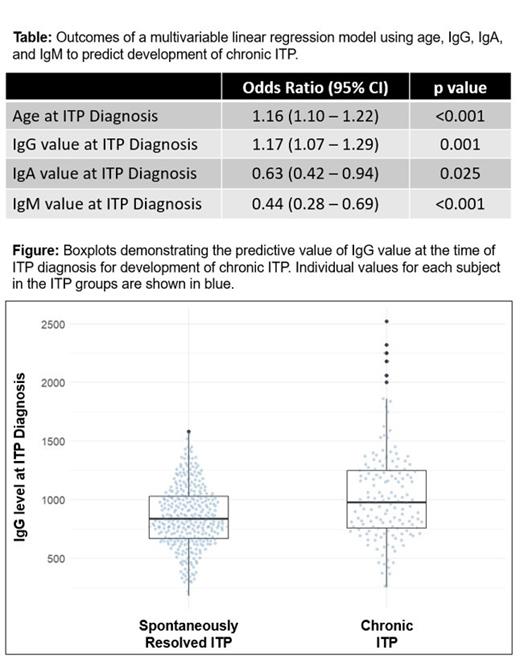Introduction: Immune thrombocytopenia (ITP) is the most common acquired bleeding disorder in children, but predictors of chronicity at the time of diagnosis remain largely unknown. Small studies have previously indicated predictive value of baseline immunoglobulin levels, but without definitive clinically applicable conclusions. We aim to further investigate the utility of immunoglobulin levels obtained at the time of diagnosis in predicting the development of chronic ITP (cITP) in children.
Methods: We completed a retrospective review of patients aged 6 months - 21 years diagnosed with ITP at tertiary referral centers from 2015 - 2022 in accordance with IRB-approved protocols. Patients with immunoglobulin levels obtained within 3 months of ITP diagnosis and prior to any treatment were included in the study. cITP was defined as ITP duration >12 months. ITP resolution was defined as achieving a platelet count > 150 x 10 9/L on 2 occasions, or on 1 occasion in the presence of normalized MPV, absent of therapy. Patients who were lost to follow-up or had ongoing disease <1 year duration were excluded. Immunoglobulins were recorded by continuous variable as well as by age-related reference values. The two groups (“spontaneously resolved” and “cITP”) were compared using Pearson's Chi-squared test for nonparametric categorical variables, Fisher's exact test for parametric categorical variables, and Wilcoxon rank sum test for nonparametric categorical variables. A multivariable logistic regression model was built to determine independent associations between immunoglobulin levels and the development of cITP after adjusting for age. R (version 4.2.1) was used for analysis. A p-value <0.05 was considered to be statistically significant.
Results: We identified 497 patients for inclusion in the study. Among these, 336 patients (67.6%) had ITP resolution prior to 12 months, while 161 patients (32.4%) developed cITP. Within the full cohort, 257 (51.7%) were male and 218 (43.9%) were Hispanic. Median age of diagnosis was 4.1 years among those with resolution, and 9.4 years among those with cITP. Patients were more likely to have secondary ITP in the cITP group vs the resolved group (37 patients [23.0%] vs 10 patients [6.2%]). Low and high IgG levels were more prevalent in cITP (5% vs 3% and 16% vs 5.7%, respectively). The median IgG level was higher in the cITP group (991 vs 838 mg/dL). Low IgA levels were more prevalent in cITP (7% vs 2.4%) and high IgA levels more prevalent in spontaneously resolving ITP (7.8% vs. 5.7%), although the median IgA level was higher in cITP (116 vs 88 mg/dL), likely attributable to older age in the cITP group. Both low and high IgM levels were more prevalent in cITP (8.9% vs 6.6% and 20% vs 16%, respectively), with the median IgM level being similar in both groups (89 vs 85 mg/dL). The age-adjusted multivariable logistic regression analysis demonstrated independent predictive value of IgG, IgA, and IgM for development of cITP (See Table, Figure). Each 100 mg/dL increase in IgG level was associated with a 17% increase in the odds of developing cITP (p=0.001); while each 100 mg/dL increase in IgA or IgM level was associated with decreased odds of developing cITP (37% [p=0.025] and 56% [p<0.001] decrease, respectively). Additionally, every 1-year increase in age was associated with a 16% increase in the odds of developing cITP (p<0.001). We also found that patients with a known secondary cause of ITP at the time of diagnosis had increased likelihood of developing cITP (p<0.001). Performance scores for the predictive model include a C-index of 0.72 and Nagelkerke R 2 of 0.21.
Conclusions: We utilized pre-treatment immunoglobulin values obtained within 3 months of diagnosis from 497 children with ITP to investigate the predictive value of immunoglobulin measurements for the development of cITP. We found that IgG, IgA, and IgM values are predictive of cITP development after accounting for age. Increasing age was also associated with increased risk of cITP. In future work, we plan to evaluate the value of additional variables for predicting the development of cITP and then validate the predictions in an external cohort. Better defining the predictive value of clinical data available at the time of ITP diagnosis will allow hematologists to provide improved prognostication and individualized management much earlier in a patient's disease course, ultimately improving the quality of care for children with ITP.
Disclosures
MacMath:National Institutes of Health: Current Employment, Other: Derek MacMath is supported in part by the Division of Clinical Research at NIAID/NIH.. Grimes:Sobi: Research Funding; Novartis: Research Funding.


